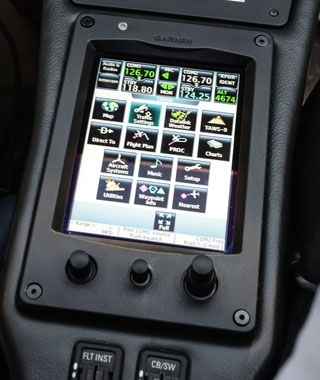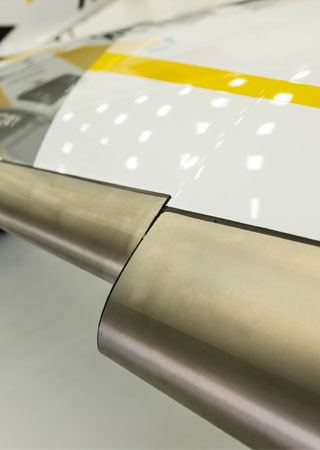Cessna's X factor
Fastest piston airplane comes screaming back, packed with new gear

Photography by Mike Fizer
With the trend line on the airspeed indicator nudging toward a rotation speed of 75 knots, I didn’t rotate, but instead squeezed my left elbow into the Cessna Corvalis TTX’s armrest. The nose popped up to fill the chevron on the flight director, set to the takeoff/go-around position, and away we went. Wichita’s steaming Runway 19L fell away at some 1,000 fpm. At 400 feet agl, I selected flaps up and nudged the stick a little to the right as the airplane smoothly cranked around to a westerly heading, the multifunction display’s magenta line showing us the way to Dodge City. With Wichita baking at 106 degrees F this day, we’re looking for someplace cooler—perhaps getting into Dodge, rather than out.
Passing 12,000 feet, the savvy Garmin G2000 cockpit system sounds a cautionary chime and posts a caution light on the panel. Since it controls the oxygen system, it knows we haven’t donned the masks. While the TTX is certified all the way up to 25,000 feet, we’ll be stopping at 12,500 because we’re missing an oxygen-line connector that will allow us to take advantage of the O2. I stick my index finger into a pulse oximeter built into the panel. A second later my pulse rate and oxygen saturation level show up in the lower left corner of the MFD. It appears I’m not going to black out in the next few minutes, so we settle in for some cruise checks.
 Rich of peak on this day where the OAT is 20 degrees C higher than standard, the airplane churns out 192 knots on 21.8 gph. Switching to lean-of-peak mode, the speed drops to 180 knots as the fuel burn settles in at 15.5 gph. At a more optimal altitude and standard temperature, the book says, the airplane will do 235 KTAS. “Two thirty-eight if it’s a little cooler than standard,” reminds Kirby Ortega from the right seat. Ortega is Cessna’s chief pilot for piston-engine flight operations.
Rich of peak on this day where the OAT is 20 degrees C higher than standard, the airplane churns out 192 knots on 21.8 gph. Switching to lean-of-peak mode, the speed drops to 180 knots as the fuel burn settles in at 15.5 gph. At a more optimal altitude and standard temperature, the book says, the airplane will do 235 KTAS. “Two thirty-eight if it’s a little cooler than standard,” reminds Kirby Ortega from the right seat. Ortega is Cessna’s chief pilot for piston-engine flight operations.
What’s the X factor? you ask—since the performance numbers are the same as the Corvalis TT, nee Cessna 400, nee (sort of) Columbia 400. Given its upbringing, the TTX has every right to be as confused as a kid dumped in foster care. Instead, the all-composite airframe and push-rod-controlled ailerons and elevator feel as solid as the future of a suburban child bound for a private prep school. Certified in the Utility category, the direct drive of the flight controls—managed from a sporty side stick—make the TTX feel more like a fighter than a piston-powered, fixed-gear, four-place business flier.
That should come as no surprise, given it was designed by Lance Neibauer of high-performance kit builder Lancair. The certification effort led to the Columbia 400, which Cessna bought out of bankruptcy and called the Cessna 400, and later the Corvalis TT. Lancair equates to speed and the TTX doesn’t disappoint, currently carrying the mantle of the fastest piston-engine airplane in production. The Cirrus SR22T and larger, pressurized Piper Mirage battle it out for second place, with published max speeds of 214 and 213 KTAS respectively.
 In all cases, these are certified performance numbers, so they have proven to be possible under standard conditions, most likely at ideal weights. Expect to see slightly more pedestrian numbers in your day-to-day flying, especially if you value fuel flows.
In all cases, these are certified performance numbers, so they have proven to be possible under standard conditions, most likely at ideal weights. Expect to see slightly more pedestrian numbers in your day-to-day flying, especially if you value fuel flows.
Like others in its category, the TTX demands tradeoffs. If you want to go a long way, you’ll not be filling more than two seats. Final performance data were not available to us at press time, but it appears that with a full 102 gallons on board you’ll have something around 377 pounds available for people and gear in an airplane equipped with air conditioning (which is standard) and a TKS anti-icing system (which is optional, but installed on the airplane we flew). Knocking the fuel down to 60 gallons saves 252 pounds and allows another adult to come along, and lots of gear, and still provides a respectable range of about 450 nm with IFR reserves.
 The X factor brings about for the first time the availability of a flight-into-known-icing certified TKS anti-icing system, which will be available in mid-2013; airbag seatbelts; an Iridium satellite transceiver for sending and receiving text messages and worldwide weather data; Garmin’s electronic stability protection (ESP), which helps keep the pilot from straying out of the performance envelope when hand-flying; and, of course, the centerpiece of the airplane—the new Cessna Intrinzic panel, powered by the touch-screen Garmin 2000 cockpit; oh, and a new T240 model number—first time Cessna has not started a model number with a “C.” The company couldn’t provide an explanation for why the change to the “T.”
The X factor brings about for the first time the availability of a flight-into-known-icing certified TKS anti-icing system, which will be available in mid-2013; airbag seatbelts; an Iridium satellite transceiver for sending and receiving text messages and worldwide weather data; Garmin’s electronic stability protection (ESP), which helps keep the pilot from straying out of the performance envelope when hand-flying; and, of course, the centerpiece of the airplane—the new Cessna Intrinzic panel, powered by the touch-screen Garmin 2000 cockpit; oh, and a new T240 model number—first time Cessna has not started a model number with a “C.” The company couldn’t provide an explanation for why the change to the “T.”
In explaining the Garmin 2000’s new touch-screen system, Ortega says, “Want to change it? Touch it.” It’s good advice. The primary and multifunction displays look similar to those in the Garmin G1000 cockpit found in the TT, except there are no knobs on the 14-inch displays, now in a widescreen configuration—like a 16:9 TV display.

There are still buttons across the bottoms of the displays. Inputs are typically done through a touch-screen controller with three knobs located on the pedestal between the front seats. Looking a little like a smartphone home page, the display’s home page has a host of icons that control the entire cockpit. Tune radios, manage the audio panel, load an approach, create or modify a flight plan, split the MFD in half—it’s all a touch or two away. Get lost in the menu? There’s a Back button and a Home button. The intuitive interface is designed to remove the need to memorize knob turns, says Ortega. Like the old-fashioned way? There’s a back-up knob interface unit on the glareshield to the left of the autopilot mode controller.
The panel is truly all glass, with the compass the only “analog” device left; dual alternators and batteries provide the electrical backup through a split bus system. The PFD/MFD can be swapped and are further backed up by dual AHRS. If all else fails, an L-3 Avionics Trilogy back-up display has its own battery and enough information to get you down safely.
The $734,000 base price is eye-widening, but delivers an impressively capable airplane. TKS is an additional $49,500. Flying only stateside? You can probably skip the ADF, an $18,750 option.
The base airplane comes with a passel of creative new paint scheme and color options, and four interior color options. Cessna announced a new custom interior and paint scheme option at EAA AirVenture in late July. Just about any combination you can dream up is possible—for a fee—as evidenced by the seemingly Cubism-inspired black, gold, and gray airplane we flew (referred to as the Steelers airplane by the staff).
TTX subassemblies are built at a Cessna plant in Mexico and shipped to Independence, Kansas, for final assembly and paint. Look for the first ones to be delivered late this year.
Email [email protected]

SPEC SHEET
Cessna Corvalis TTX
- Base price: $734,000
- Powerplant | 310-hp Continental TSIO-550-C
- Recommended TBO | 2,000 hr
- Propeller | McCauley 78 in constant speed
- Length | 25 ft 34 in
- Height | 9 ft
- Wingspan | 35 ft 10 in
- Wing area | 141.2 sq ft
- Wing loading | 25.5 lb/sq ft
- Power loading | 11.6 lb/hp
- Seats | 4
- Cabin length | 11 ft 6 in
- Cabin width | 4 ft
- Cabin height | 4 ft 1 in
- Empty weight | 2,600 lb
- Empty weight as tested | 2,630 lb
- Max ramp weight | 3,600 lb
- Max gross weight | 3,600 lb
- Useful load | 1,000 lb
- Useful load as tested | 970 lb
- Payload w/full fuel as tested | 358 lb
- Max takeoff weight | 3,600 lb
- Max landing weight | 3,420 lb
- Zero fuel weight | 3,300 lb
- Fuel capacity, std | 106 gal (102 gal usable) 636 lb (612 lb usable)
- Oil capacity | 10 qt
- Baggage capacity | 120 lb, 39.5 cu ft
- Performance
- Takeoff distance, ground roll | 1,300 ft
- Takeoff distance over 50-ft obstacle | 1,900 ft
- Max demonstrated crosswind component | 23 kt
- Rate of climb, sea level | 1,400 fpm
- Max level speed, sea level | 182 kt
- Max level speed, 25,000 ft | 235 kt
- Cruise speed/endurance w/45-min rsv, std fuel (fuel consumption)
- @ 75% power, best economy 25,000 ft (16.8 gph) 227 kt/5.25 hr
- @ 65% power, best economy, 25,000 ft (15 gph) 218 kt/6 hr
- @ 55% power, best economy, 25,000 ft (13 gph) 208 kt/7 hr
- Max operating altitude | 25,000 ft
- Landing distance over 50-ft obstacle | 2,600 ft
- Landing distance, ground roll | 1,250 ft
- Limiting and Recommended Airspeeds
- VX (best angle of climb) | 82 KIAS
- VY (best rate of climb) | 110 KIAS
- VA (design maneuvering) | 158 KIAS
- VFE (max flap extended) | 117 KIAS
- VNO (max structural cruising) | 181 KIAS
- VNE (never exceed) | 230 KIAS
- VR (rotation) | 75 KIAS
- VS1 (stall, clean) | 73 KIAS
- VSO (stall, in landing configuration) | 60 KIAS
For more information
- Contact Cessna Aircraft Company, One Cessna Boulevard, Wichita, Kansas 67215; 800-835-4057
- All performance figures are based on standard day, standard atmosphere, sea level, gross weight conditions unless otherwise noted.
Extra
- Fastest single-engine piston in production. Range at max cruise, no wind—825 nm.
- Includes two-year warranty; extended warranty available.



